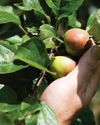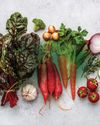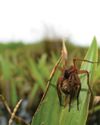Chalk hills roll and plunge into frosty combes, cool mists swirl around wooded slopes and cosy villages await winter wanderers. Pull on your boots and scarf to explore the South Downs this January.

The diadem of magical places that we call the South Downs reaches out from the chalk lands of southern Hampshire deep into the kingdom of Sussex. It is hard to determine where the downs start, but they end dramatically and conclusively, plunging into the English Channel at Beachy Head, immediately east of the Seven Sisters, near Eastbourne.
Like the North Downs of Kent and Surrey, they consist of a steep scarp slope and a long, more gentle dip slope. In the South Downs, the escarpment faces north, which renders the turf cool and mossy, while the dip slope ambles away southwards, towards the English Channel, and is dissected by deep and hidden dry valleys, known as combes. Much of this gently sloping land consists of vast arable fields, open plough-land in winter.
Four swollen brown rivers cut through and divide up the South Downs – the Arun, Adur, Ouse and Cuckmere. Each of the resultant sections of downland is distinctive, but the greatest landscape character difference lies between the western downs, of Hampshire and West Sussex, which are often steep,incised and wooded, and those of East Sussex, which are open and rolling.
HAMLETS AND HOUSES
The built environment is as strong an element of the South Downs as the natural and farmed environments and one which the establishment of the South Downs National Park Authority in 2010 will help to conserve. Local distinctiveness is profound here, from the villages that have sprung up around the clear streams that bubble up where chalk meets the gault clay at the foot of the downs’ escarpment, to those snuggled away in hidden valleys, or the hillside hamlets miles from anywhere.
This story is from the {{IssueName}} edition of {{MagazineName}}.
Start your 7-day Magzter GOLD free trial to access thousands of curated premium stories, and 9,000+ magazines and newspapers.
Already a subscriber ? Sign In
This story is from the {{IssueName}} edition of {{MagazineName}}.
Start your 7-day Magzter GOLD free trial to access thousands of curated premium stories, and 9,000+ magazines and newspapers.
Already a subscriber? Sign In

Guilt-Free Meat? - Should the world stop eating meat to tackle the climate crisis? Chris Baraniuk meets an experimental farmer who says we don't all have to become vegetarians
Should the world stop eating meat to tackle the climate crisis? Chris Baraniuk meets an experimental farmer who says we don't all have to become vegetarians. Livestock farming around the world is facing scrutiny because of its greenhouse gas emissions. Globally, the sector contributes somewhere between 11.1% and 19.6% of total emissions. Meat production is roughly twice as bad as the production of plant-based food, according to some analyses. And beef is the worst of all. Study after study has suggested that, in order to curtail the devastating effects of climate change, we ought to shift to a diet containing less meat - or even go vegetarian or vegan.

Discover Cider Country - Explore mellow golden countryside, pedalling between medieval villages, historic inns and fruitful orchards, on a delightful Herefordshire Cider Circuit adventure with Julie Brominicks
Explore mellow golden countryside, pedalling between medieval villages, historic inns and fruitful orchards, on a delightful Herefordshire Cider Circuit adventure with Julie Brominicks. I'm cycling Porter's Perfection, one of three cider circuits developed for Visit Herefordshire over the past few years. Each showcases a section of this bucolic county's loveliest villages, pubs, orchards and cidermakers via lanes suited to bicycles - e-bikes for hill-averse cyclists like me. The idea is to allow you to appreciate the sights, sounds and smells of cider country while traversing roads never meant for modern cars. If you have dodgy knees, or are keen to indulge in the local adult apple juice as you go (remember, it's illegal to cycle while under the influence), Visit Herefordshire also promotes cider bus routes.

TOP 10 WILD AUTUMN FOODS
Make the most of seasonal abundance with foraging tips and recipe ideas from wild food expert Liz Knight

The taste of England
Amid pastures farmed by her family for more than four centuries, Mary Quicke is reviving forgotten dairy traditions to produce delicious Devon cheeses

How to eat 30 plants a week
As science proves the many health-boosting benefits of eating at least 30 different plants each week, Hugh Fearnley-Whittingstall shares recipes to help you meet the magic target

RARE RAFT SPIDER MAKES A COMEBACK
Thanks to dedicated conservation work, this impressive but vulnerable arachnid is resurgent in East Anglia

SPECTACULAR STONEHENGE FINDS
Following the latest astonishing revelation about the Stonehenge Altar Stone's Scottish origins, Dixe Wills looks at recent discoveries that have changed the way we view this impressive and enigmatic Neolithic monument

GALLOWAY NATIONAL PARK DEBATE
Would this protected status bring welcome recognition and attention - or overcrowding and problems for farmers?

Farmers are valued, so why do they feel we don't care?
For farmers out in their fields in all seasons, worried about the future as dramatic levels of rainfall blamed on climate change damage their crops, inflation and uncertainty push up their costs and what they see as unfair imports threaten their livelihoods, here's a spot of unexpectedly good news: the rest of us think you are doing a good job.

Pumpkin patches
Find the perfect jack-o'-lantern for Halloween at a pick-your-own pumpkin patch. Some are simple affairs in tranquil countryside; others offer activities ranging from ghost trains to spooky mazes.